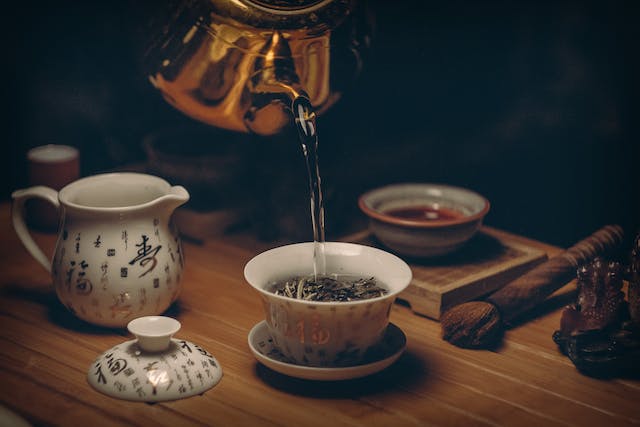
What is tea? It is a drink made from pouring hot water over tea leaves, which come from the camellia sinensis shrub.
There are many different kinds of tea available today, but most of them are not technically “tea”. It is a commonly held belief that a “tea” is a drink made from pouring hot water over any kind of leaves, herbs, or spices, but that is not true. These are often called herbal teas, but, unless they contain leaves from the tea plant, they are not technically teas.
Tea is made by pouring hot water over the leaves of the camellia sinensis, which is known as the tea plant. There are two different types of camellia used for tea. There is the camellia sinensis and the camellia assamica. Tea is grown in many different places at the moment, but tea plants are native to East Asia, which is where the tradition of drinking tea came from. The tea plant probably first appeared in the area where Burma is today. It was then transplanted throughout Asia. Tea has been drunk in China for thousands of years. Legend says that tea was first drunk in 2727 BC when some tea leaves fell into a pot of boiling water that was about to be served to the Emperor Shen Nong. This is probably not true, but tea was certainly a part of the Chinese diet for a long time. People ate tea leaves and added them to soups before they started to drink them as a drink. Tea didn’t really spread to the rest of the world until the 15th century, when it was traded out of China.
Our word for “tea” has come about because of the way tea was traded into Europe. There are two words for tea in Asia. The Malay word for tea is “teh” and the Chinese (both Cantonese and Mandarin) word is “cha”. Tea was traded out of Malay and out of China. All of the countries that got their tea from Malay, use a form of the word “teh” and all of the countries that got their tea from China use a variation of the word “cha”. The Portuguese traded with China, in Macao, and they took tea to many different countries, where it is called a variation on “cha”. “Chai” in Russian, “tsai” in Greek, “shay” in Arabic, and “çay” in Turkey. The first tea in England came from Portuguese traders and it was called cha until the 17th century. The Dutch traded with Malay and brought tea to most of Europe, where it is called variations on “teh”. “Tea” in English, “thé” in French, “te” in Spanish, “Tee” in German, and “thee” in Dutch.
There are generally four types of tea that can be made from the tea plant. Those are white, green, oolong, and black. Each one differs in the way it is processed and how oxidized the leaves are. When the leaves are picked, they start to oxidize straight away. When the leaves are exposed to the oxygen in the air, enzymes in them start to break down chlorophyll and release tannins. The chlorophyll is responsible for the green color in leaves and the more they are allowed to oxidize, the darker they get. White tea is made from young leaves and buds that are picked and dried without oxidizing. Green teas are made from leaves that are not allowed to oxidize, which is why they are still green. They are heated just after they are picked to halt the oxidization process. Oolong teas are made from leaves that are slightly oxidized. The leaves are rolled and twisted, which bruises them, adding to their flavor. Leaves are allowed to oxidize for different lengths of time, making a lot of different flavors of tea. Black tea is oxidized the most, which is why it is black. It is much higher in caffeine than other teas. The leaves are mixed and cut so that all of the cells in them can oxidize.
Tea leaves are made up of soluble and insoluble parts. The insoluble parts are the fiber, cellulose, chlorophyll, and all of the other parts of a leaf that we can’t digest when we eat them. The soluble parts are polyphenols, amino acids, minerals, caffeine, and some other stimulants. When we add tea leaves to hot water, the insoluble parts stay in the pot, or in the teabag, and the soluble parts get dissolved into the water and go into our cup. These soluble parts carry the tastes, the colors, and the scents that we know and love in our teas. And this is what I learned today.
Photo by MYKOLA OSMACHKO: https://www.pexels.com/photo/gold-kettle-pouring-hot-water-on-cup-of-tea-230477/
Sources
https://www.teamuse.com/article_111103.html
https://www.peets.com/blogs/peets/a-history-of-tea
https://www.tea.co.uk/history-of-tea
https://en.wikipedia.org/wiki/Tea
https://www.etymonline.com/word/tea
https://artfultea.com/blogs/tea-wisdom/tea-oxidation
